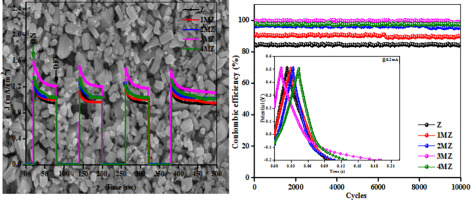当前位置:
X-MOL 学术
›
J. Electroanal. Chem.
›
论文详情
Our official English website, www.x-mol.net, welcomes your
feedback! (Note: you will need to create a separate account there.)
Structural, optical, and bifunctional applications: Supercapacitor and photoelectrochemical water splitting of Ni-doped ZnO nanostructures
Journal of Electroanalytical Chemistry ( IF 4.1 ) Pub Date : 2018-11-01 , DOI: 10.1016/j.jelechem.2018.09.048 I. Neelakanta Reddy , Ch. Venkata Reddy , Adem Sreedhar , Jaesool Shim , Migyung Cho , Kisoo Yoo , Dongseob Kim
Journal of Electroanalytical Chemistry ( IF 4.1 ) Pub Date : 2018-11-01 , DOI: 10.1016/j.jelechem.2018.09.048 I. Neelakanta Reddy , Ch. Venkata Reddy , Adem Sreedhar , Jaesool Shim , Migyung Cho , Kisoo Yoo , Dongseob Kim

|
Abstract Over the past few decades, doped ZnO structures have attracted significant attention because of their distinctive properties and a wide range of applications in catalysis and energy-storage devices. However, effective simple synthesis of doped ZnO structures for photoelectrocatalytic and supercapacitor applications still remains challenging. In this study, Ni-doped ZnO structures were synthesized at different Ni concentrations. Analysis of the obtained samples confirmed the formation of Ni-doped ZnO; 1.5 mol% Ni-doped ZnO showed enhanced water splitting activity and supercapacitor properties. The highest photocurrent density of 4.6 mA/cm2 was obtained in a 0.1 M KOH solution at an applied bias photon-to-current efficiency of 4.2%, which is almost twice that obtained with pristine ZnO (2.8%), indicating an enhanced electron-hole separation. Doped ZnO exhibits a photocurrent 1.78 times higher than pristine ZnO under light illumination. Ni-doping induces effective charge separation and transfer, efficiently diminishing the recombination rate and reducing intrinsic defects. Further, the highest specific capacity of ~96 F g−1 was observed for 1.5% Ni-doped ZnO at an applied scan rate of 10 mV s−1. The optimized sample, 1.5% Ni-doped ZnO, exhibited a high specific capacitance retention and coulombic efficiency of ~98% and ~99.2%, respectively. These results are expected to be very helpful in developing cheap and simple fabrication methods and efficient electrode materials for photoelectrochemical water splitting and supercapacitor applications.
中文翻译:

结构、光学和双功能应用:超级电容器和 Ni 掺杂 ZnO 纳米结构的光电化学水分解
摘要 在过去的几十年里,掺杂的 ZnO 结构因其独特的性质和在催化和储能设备中的广泛应用而引起了极大的关注。然而,用于光电催化和超级电容器应用的掺杂 ZnO 结构的有效简单合成仍然具有挑战性。在这项研究中,在不同的 Ni 浓度下合成了 Ni 掺杂的 ZnO 结构。对所得样品的分析证实了 Ni 掺杂的 ZnO 的形成;1.5 mol% Ni 掺杂的 ZnO 显示出增强的水分解活性和超级电容器性能。在 0.1 M KOH 溶液中以 4.2% 的偏置光子电流效率获得 4.6 mA/cm2 的最高光电流密度,几乎是使用原始 ZnO (2.8%) 获得的两倍,表明增强的电子-孔分离。在光照下,掺杂的 ZnO 表现出比原始 ZnO 高 1.78 倍的光电流。Ni掺杂诱导有效的电荷分离和转移,有效降低复合率并减少固有缺陷。此外,在 10 mV s-1 的应用扫描速率下,对于 1.5% Ni 掺杂的 ZnO,观察到了 ~96 F g-1 的最高比容量。优化的样品,1.5% 的 Ni 掺杂 ZnO,表现出高的比电容保持率和库仑效率,分别为 ~98% 和 ~99.2%。预计这些结果对于开发用于光电化学水分解和超级电容器应用的廉价且简单的制造方法和有效的电极材料非常有帮助。Ni掺杂诱导有效的电荷分离和转移,有效降低复合率并减少固有缺陷。此外,在 10 mV s-1 的应用扫描速率下,对于 1.5% Ni 掺杂的 ZnO,观察到了 ~96 F g-1 的最高比容量。优化的样品,1.5% 的 Ni 掺杂的 ZnO,表现出高的比电容保持率和库仑效率,分别为 ~98% 和 ~99.2%。预计这些结果对于开发用于光电化学水分解和超级电容器应用的廉价和简单的制造方法和有效的电极材料非常有帮助。Ni掺杂诱导有效的电荷分离和转移,有效降低复合率并减少固有缺陷。此外,在 10 mV s-1 的应用扫描速率下,对于 1.5% Ni 掺杂的 ZnO,观察到了 ~96 F g-1 的最高比容量。优化的样品,1.5% 的 Ni 掺杂 ZnO,表现出高比电容保持率和库仑效率,分别为 ~98% 和 ~99.2%。预计这些结果对于开发用于光电化学水分解和超级电容器应用的廉价且简单的制造方法和有效的电极材料非常有帮助。5% Ni 掺杂的 ZnO 表现出高比电容保持率和库仑效率,分别为 ~98% 和 ~99.2%。预计这些结果对于开发用于光电化学水分解和超级电容器应用的廉价且简单的制造方法和有效的电极材料非常有帮助。5% Ni 掺杂的 ZnO 表现出高比电容保持率和库仑效率,分别为 ~98% 和 ~99.2%。预计这些结果对于开发用于光电化学水分解和超级电容器应用的廉价且简单的制造方法和有效的电极材料非常有帮助。
更新日期:2018-11-01
中文翻译:

结构、光学和双功能应用:超级电容器和 Ni 掺杂 ZnO 纳米结构的光电化学水分解
摘要 在过去的几十年里,掺杂的 ZnO 结构因其独特的性质和在催化和储能设备中的广泛应用而引起了极大的关注。然而,用于光电催化和超级电容器应用的掺杂 ZnO 结构的有效简单合成仍然具有挑战性。在这项研究中,在不同的 Ni 浓度下合成了 Ni 掺杂的 ZnO 结构。对所得样品的分析证实了 Ni 掺杂的 ZnO 的形成;1.5 mol% Ni 掺杂的 ZnO 显示出增强的水分解活性和超级电容器性能。在 0.1 M KOH 溶液中以 4.2% 的偏置光子电流效率获得 4.6 mA/cm2 的最高光电流密度,几乎是使用原始 ZnO (2.8%) 获得的两倍,表明增强的电子-孔分离。在光照下,掺杂的 ZnO 表现出比原始 ZnO 高 1.78 倍的光电流。Ni掺杂诱导有效的电荷分离和转移,有效降低复合率并减少固有缺陷。此外,在 10 mV s-1 的应用扫描速率下,对于 1.5% Ni 掺杂的 ZnO,观察到了 ~96 F g-1 的最高比容量。优化的样品,1.5% 的 Ni 掺杂 ZnO,表现出高的比电容保持率和库仑效率,分别为 ~98% 和 ~99.2%。预计这些结果对于开发用于光电化学水分解和超级电容器应用的廉价且简单的制造方法和有效的电极材料非常有帮助。Ni掺杂诱导有效的电荷分离和转移,有效降低复合率并减少固有缺陷。此外,在 10 mV s-1 的应用扫描速率下,对于 1.5% Ni 掺杂的 ZnO,观察到了 ~96 F g-1 的最高比容量。优化的样品,1.5% 的 Ni 掺杂的 ZnO,表现出高的比电容保持率和库仑效率,分别为 ~98% 和 ~99.2%。预计这些结果对于开发用于光电化学水分解和超级电容器应用的廉价和简单的制造方法和有效的电极材料非常有帮助。Ni掺杂诱导有效的电荷分离和转移,有效降低复合率并减少固有缺陷。此外,在 10 mV s-1 的应用扫描速率下,对于 1.5% Ni 掺杂的 ZnO,观察到了 ~96 F g-1 的最高比容量。优化的样品,1.5% 的 Ni 掺杂 ZnO,表现出高比电容保持率和库仑效率,分别为 ~98% 和 ~99.2%。预计这些结果对于开发用于光电化学水分解和超级电容器应用的廉价且简单的制造方法和有效的电极材料非常有帮助。5% Ni 掺杂的 ZnO 表现出高比电容保持率和库仑效率,分别为 ~98% 和 ~99.2%。预计这些结果对于开发用于光电化学水分解和超级电容器应用的廉价且简单的制造方法和有效的电极材料非常有帮助。5% Ni 掺杂的 ZnO 表现出高比电容保持率和库仑效率,分别为 ~98% 和 ~99.2%。预计这些结果对于开发用于光电化学水分解和超级电容器应用的廉价且简单的制造方法和有效的电极材料非常有帮助。











































 京公网安备 11010802027423号
京公网安备 11010802027423号